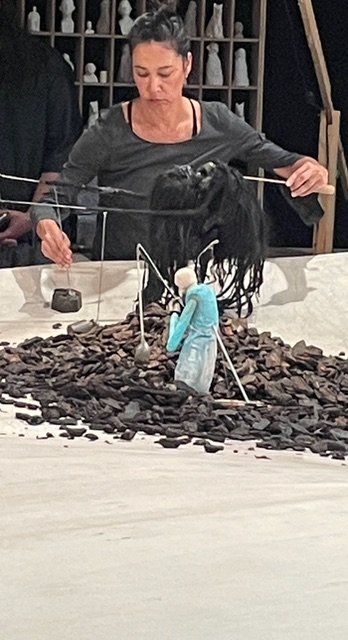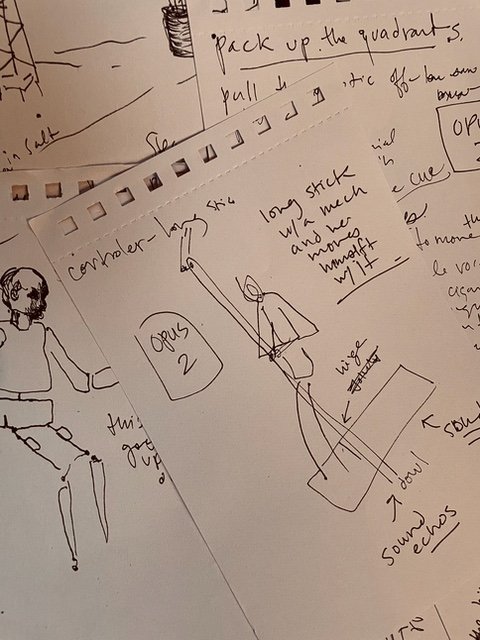Building Worlds of Sound
/Observations from the 2023 World Festival of Puppet Theaters in Charleville-Mézières: Part 1
by Felice Amato
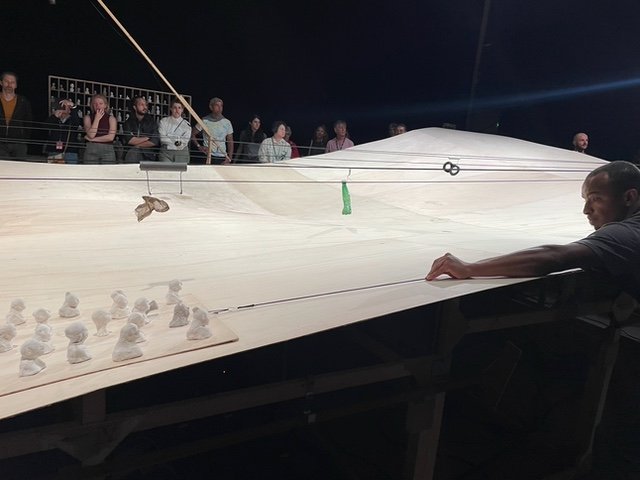
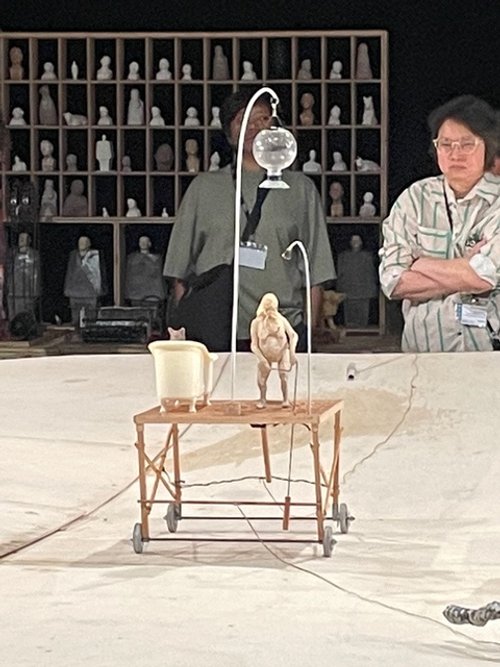
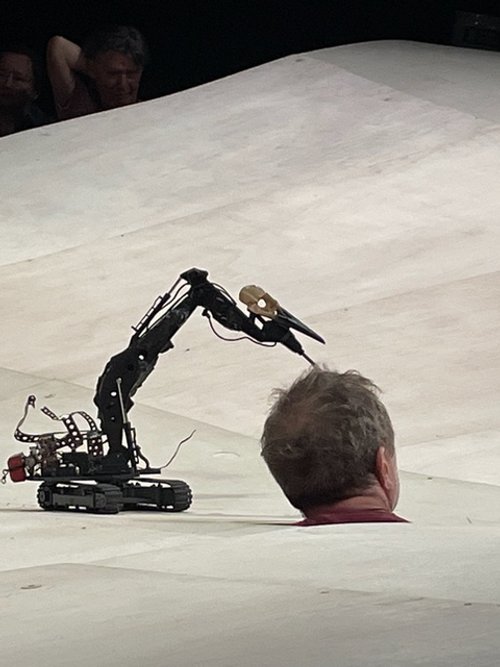
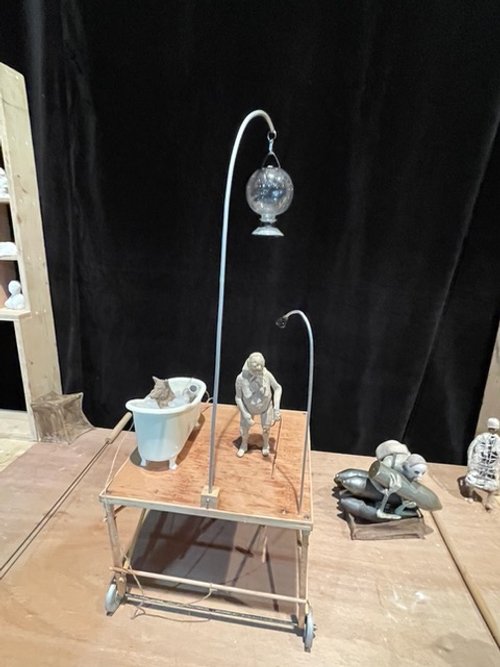
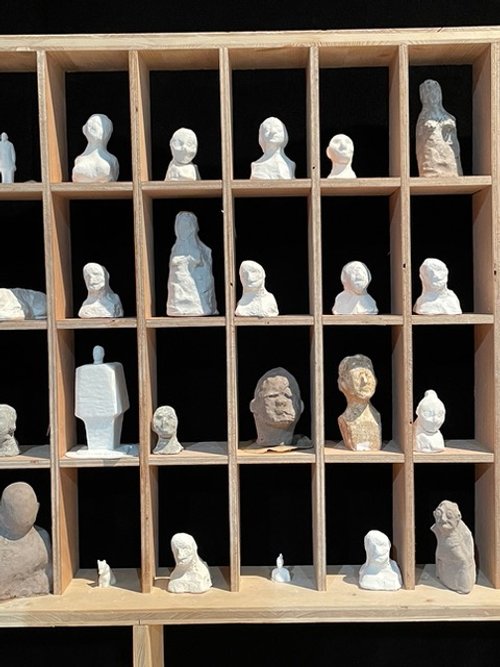
One of three immersive works by E. Garcia Romeu, Opus 2 of Le Petite Theatre du Bout du Monde (or The Little Theater at the End of the World) was staged in the gym of the Franck-Mozart Primary School, in Charleville. A large space with high ceilings, it is dark. An enormous white table-like surface, which is itself the size of a small room, is lit at the center. It is reminiscent of a skate park, made of undulating chipboard, bolted together to form the suggestion of a barren landscape. Entering along the side, one can examine tables and shelves that function like cabinets of curiosity, filled with little objects and statues to be used throughout the piece. There are only a few chairs because this is an ambulatory performance, and the audience will move around, encouraged to take photos and even film. The piece is a performative installation, where four puppeteers set up, take down, and arrange objects to form a stream of vignettes—some momentary. In this piece, sound helps build each scene, disconnecting us from where we are and were, rebuilding the world through our auditory perception. I think back to what puppeteer Omayra Martinez-Garzon asserts:
50% of each of her pieces is what she calls the “sound world.” That is certainly the case in this piece and something that captured my imagination at the festival overall. Soundscapes are fundamental in worldmaking.
One of the remarkable things about the festival is the sheer number of venues that are activated all over the city. There are theaters and auditoriums of various sizes, styles, and states of upkeep. There are shows in libraries, tents in the park, and even the meeting rooms of a worker’s syndicate. I imagine that arriving, most companies find themselves assigned to one of these many venues around the city. Depending upon what they discover, they are challenged with either accepting (and even embracing) the context or redefining the space, transforming it from the quotidian to a world apart.
At one point in Opus 2, the largest and thinnest plastic sheeting is brought up and over the vast white surface, rustling and hushing as it billows: snowfall. I note the synesthetic quality of the soft brushing sound of the plastic skin as though it has touched my skin. At one point, the puppeteers pull boxes from below the far corners of the white ground. They use clips to attach beautifully-crafted, miniature light posts to the edges at these 4 quadrants. They seem to be artifacts of a prison or a bleak, abandoned industrial park in another time (perhaps even a future time). Then, in the small circles of light, the puppeteers place several small guard dog figurines in a row. Soon we begin to hear dogs bark and howl and then to answer each other from these 4 locations, isolated, with a sonorous expanse dividing them. (There must be 4 small speakers hidden at each corner.) The sound has sketched the distance and the mood. And then, just as I become lost in the landscape, the puppeteers efficiently disassemble this world, where sound was the only animation. There is animation in the piece, but much of the show consists of a continual setting and dismantling. The effort expended on each scene, the crafting of objects and mechanisms, and the way that each item is touched as it is placed seems purposefully absurd. And perhaps that is the point.
Sound does many things. It sets an emotional tone and lends a rhythm (even activating the audience’s heartbeat). It can establish a location or setting by providing contextual cues (birds, traffic, or waves crashing). As with the lonely howls of the dogs (and other sounds that came through hidden speakers dispersed throughout the room), it can also create architecture. In “Intro to Sound Design for Theatre,” Gil Eva Craig describes how live theater offers an opportunity to extend the dramatic space: “The experience of watching theatre is a three dimensional experience …. The placement of sound in a set can enhance the actual physical space the action is happening in, and … manipulate the physical space the audience is in.”
My notes are full of being struck by the sounds. I scrawl things like: “lots of pouring things out to shape space-sound-percussive gestures (rice? coarse salt?)” and “knock-amplified-wood-like” and “shuffle” and “odd voice.” There is an operator at a mixing console in the midst of it all, controlling the part of the soundscape that includes a pre-recorded mix: discordant and unpredictable notes, ambient steampunk vibes, raspy song lyrics, and historical found-sound (a political speech in Spanish). There is distortion at times, but I also write: “sound crisp echo.” And while there are sound effects, the puppets and props––and even the set–– generate their own clicks and ticks. The little wooden snow rakes, that the audience sees, scrape in a wooden way, that the audience hears. The animation is automata-like, gadgety with mechs and gears. The figures and objects are rigged to do something in an overly-complicated and ingenious way that ultimately has little effect. The puppeteers’ efforts and focus imbue the pointlessness with significance. These excessively engineered quirks suggest a programmed and poetry-less society––a theme throughout. Or maybe there is a poetry of futility.
There is overlap in the vignettes and sound helps us focus on what is arriving. Simultaneous with other happenings, there is a grinding whirr, a jarring and unmistakable sonic foreshadowing. Then, much to the audience’s disbelief, the lead puppeteer uses an electric saw to cut a huge hole in the landscape from below, his head emerging to join the set. Another puppeteer arranges numerous crude little clay busts on a long strip of fabric. Then, as these figureheads are dragged across space, a military fanfare is played. We suddenly understand this little provisional-feeling “sketch” of objects and movement to be a procession in a not-quite-generic time and place. The crudeness of the busts tells us something about the undeserved pomp and circumstance of leaders in a crumbling authoritarian society.


